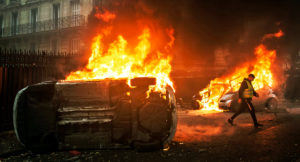France is no longer the country of Notre-Dame, nor the country of De Gaulle, where the Concorde was built and a broad middle-class prospered. To understand this moment of profound transition, you have to look past the results of last weekend’s Presidential election first round, and beyond the forthcoming run-off between Emmanuel Macron and Marine Le Pen. Election campaigns can only tell us so much.
What is happening to France, as sociologist Jerôme Fourquet observed, is best understood as “the Great Metamorphosis”. Nobody has done more than Fourquet to peel away the misapprehensions that surround French society, and reveal what it is now, or what it will look like in the future. He is the sociologist of France as it is, not what it once was, or how The Economist or Financial Times wishes it to be.
“The Great Metamorphosis” began, Fourquet argues in La France sous nos yeux (2021), in the Eighties. That was the decade France’s cultural core began to collapse in on itself, and the features of French society in its present form began to surface.
In 1983 strikes and violent protests by auto-workers, mostly immigrants from the Maghreb, made the Muslim minority visible to France for the first time. Images of the riots propelled the Front National to its first significant successes in the European elections of 1984. France’s agonies over migration had begun.
Then, in 2005, French voters rejected the European Constitution in a referendum — despite its backing by most of the French media and political class. Here, Fourquet believes, a new divide could be seen for the first time, one that would determine political conflict going forward: between those who benefited from globalisation, and those who did not.
Against this backdrop of intensifying political discontent, French culture was changing. Older mores were disappearing, especially Christian ones, and Catholic ones in particular. Fourquet strikingly demonstrates the disappearance of the Church’s influence on French sensibilities. In 1961, 38% of French Catholics declared that they went to Mass every Sunday. By 2012, only 7% did. This sharp decline in the number of practising Catholics was matched by a shrinking number of vocations. At the outbreak of the Revolution, the number of priests, 170,000, was almost equal to their number in 1950. By 2015, it had fallen to 51,500. If the current trend continues there won’t be a single Catholic priest left in France in 30 years.
Released from this crumbling framework, French attitudes towards marriage, homosexuality, and children born to unmarried parents changed dramatically. In the Sixties, marriage was still the dominant social norm, but today it has ceased to be so. In 1980, 11.4% of children were born out of wedlock; by 1990 it was 30% and by 2005, more than half the children were born outside of marriage. If a teacher had started his career in 1980, he would have taught a class in which almost all the children had married parents. By the time of his retirement, however, that ratio would have inverted.
The last stand of French Catholicism came when Francois Hollande legalised gay marriage in 2013. To an extent unseen in the United Kingdom, or Germany, or Spain, French Catholics mobilised against Hollande’s decision. La Manif pour tous marches drew tens of thousands of participants who disagreed with the new law, but to no avail. Catholics finally realised they were a minority, one of the islands in the “French archipelago”, as the title of one of Fourquet’s books goes. Dechristianisation, he believed, had entered its “terminal stage”.
Nature famously abhors a vacuum. As Christianity receded other forces began to influence French society. Emancipation from tradition led to individualism. Fourquet measures this in birth names: In the early Sixties, the number of newborns with rare names — those that had been given to no more than three people so far — was less than 6,000. By 1990, it had jumped to nearly 18,000. But the real explosion came in 2016, when as many as 55,000 newborns bore rare names. And the cultural component of Catholicism was replaced by American pop culture.
Americanisation, Fourquet writes, has profoundly transformed France. Although 27% of French people have visited the US at least once, every second person among the wealthy has done so. The upper classes are fluent in English — Macron voters were the most proficient in this language, while Le Pen voters were the least — and consume mostly American media.
The less fortunate have their own cultural markers of Americanisation. Again, Fourquet analyses names. The Maries of French tradition were replaced by Kevins (after Home Alone) and Dylans (after Beverly Hills 90210). The map of these American names coincides with the places where Marine Le Pen can count on her firmest support. Many National Rally activists bear names such as Jordan Bardella, today the number two in the party, or Davy Rodriguez, who headed its youth organisation. More phenomena of this kitschy low-status Americanisation include the immense popularity of country music clubs, vintage US cars, and pole dancing across France, as well the spread of the Buffalo Grill restaurant chain in hundreds of locations.
Both the elites and the working classes began to dream American dreams. Fourquet calls one of them the “Plaza majority” lifestyle, after the name of the celebrity real estate agent Stéphane Plaza. In his TV shows, he advertises an ideal shared across French society: a house with a garden, a desire that mimics the American suburban lifestyle. Depending on the class, this ideal assumes different forms, but it often includes a swimming pool. This vision of affluence from America captured the imagination of the French, who have built 1.3 million pools in their country. Elsewhere, Fourquet says the last common experience of the “French archipelago” is a visit, or “pilgrimage” to Disneyland — 75% of those under 35 have visited the theme park.
Americanisation was the only component of globalisation that did not bitterly divide the French. According to Fourquet the split between those for whom globalisation meant achievement and those for whom it meant dispossession, would, from 2017, become central to understanding France. As in the United States and Britain, globalisation swept the French economy. As in the United States and Britain, its impact could have perverse consequences.
At the turn of the century, the French telecommunications manufacturer Alcatel had 120 different types of plants scattered around the country. One of them was located in Lannion. This is where Minitel was created and where the first French portable phone, Bi-bop, was invented. In 2001 Alcatel’s CEO declared that in the new economy factories were not necessary. Thousands of Lannion residents lost their jobs. Between 1999 and 2004 the city lost 10% of its population — then between 2004 and 2017 it fell by another 20%.
What happened to Lannion residents? They dropped out of the middle class, which was everywhere being reshaped by “the Great Metamorphosis”. It led to a phenomenon that Fourquet calls “bipolarisation”; society begins to resemble an hourglass. The middle class disintegrates, its lower strata falling into the lower classes and its upper strata ascending into the upper classes.
This process can be seen in leisure activities. The Trente Glorieuses were a time of upward social mobility, which translated into democratisation of ski slopes. While it used to be that entire middle class families went skiing, today skiing has become an activity that only the well-off can afford. The appearance of hard discount stores represents another sign of the erosion of the middle class. Its less affluent members cannot afford to maintain their consumption habits. This also, as Fourquet points out, explains the ominous success of Dacia cars. This Romanian brand, bought out by Renault, was originally intended as a way to expand into Eastern European markets. However, Dacia has enjoyed great popularity in France, allowing those who otherwise would have to turn to a used car to buy a new one.
Dacia drivers in the new France were more likely to work in warehouses, schools, and nursing homes than factories. It was these workers who became the backbone of the Gilets Jaunes movement. The protestors were the people who Fourquet had studied for decades; “the proletariat working in logistics and services”, and those who juggled several jobs to make ends meet. Jacline Mouraud, a Gilets Jaunes in the protest delegation which met with the French government, simultaneously worked as a hypnotherapist, an accordionist, and a security guard. Fourquet sees the Gilets Jaunes as an example of the “subaltern class” once described by Gramsci. Similar to the farmers of the Italian Mezzogiorno, constantly agitated, but unable to articulate their grievances successfully.
In Fourquet’s work we can see the patterns that have come to define modern France. The detachment of the elites from their country; the splintering of the middle-class; the collapse of centuries old traditions. His analyses clarify French politics. A Fourquet reader might have predicted Eric Zemmour’s failure to pick up the Rassemblement National vote over the weekend. The electorate of Kevins who sing country music and enjoy Buffalo Grill belongs to a different universe than the de Maistre-quoting essayist from Paris who recorded his best results in Saint-Tropez.
Without Fourquet’s writings, it can be difficult to grasp that the run-off between Macron and Le Pen is more than a political battle. It is a clash between two worlds within France, between the two halves of Fourquet’s hourglass. A confrontation, as Disraeli once wrote of a divided England, of “two nations, between whom there is no intercourse and no sympathy; who are as ignorant of each other’s habits, thoughts, and feelings, as if they were dwellers in different zones, or inhabitants of different planets.”
What will France be after France? Fourquet warned that the islands of the French archipelago will continue to drift apart. Stark differences in consumption, lifestyles, mobility, and wealth would only sharpen. He believed there were two ways to end this fragmentation. A new electoral system, based on proportional representation. And a final abandonment of France’s old Left-Right divide, and the acceptance of a new politics, contested on one side by the winners of globalisation, with the losers on the other side.
Proportional representation seems a distant prospect. But on Sunday, France, where politics had been structured for over half a century around two parties, changed dramatically. The socialists were irrelevant by 2017. Now Les Républicains cannot even obtain 5% of the vote. In the run-off, for the second time in a row, we will witness a showdown between the candidate of France for whom the future and globalisation mean the same thing and the candidate of France for whom globalisation means decline. French politics has finally come to represent the society described by Fourquet.
Disclaimer
Some of the posts we share are controversial and we do not necessarily agree with them in the whole extend. Sometimes we agree with the content or part of it but we do not agree with the narration or language. Nevertheless we find them somehow interesting, valuable and/or informative or we share them, because we strongly believe in freedom of speech, free press and journalism. We strongly encourage you to have a critical approach to all the content, do your own research and analysis to build your own opinion.
We would be glad to have your feedback.
Source: UnHerd Read the original article here: https://unherd.com




